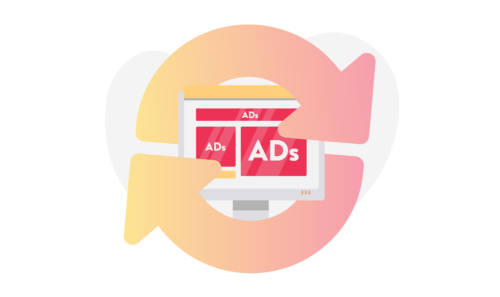Google Ad Sense vs. Google Ad Manager
Let’s say you have just uploaded a new post on a blog you have recently launched. You’re sipping your morning latte and checking how it all looks. You have just read once again what you had been writing for the last five days, knowing the content almost by heart. You start to scan the text, paragraph by paragraph, roughly checking if everything is in place and if you haven’t missed anything. There are the graphics you received late last night from your amateur designer friend – just a quick look. Okay, it seems on point.

Now let’s assume you have been running your blog already for a few months. The number of your users is growing visibly, your features are popular and users share links to your blog to inspire each other. “What if I displayed some ads?”, comes to your mind for the first time.
Great, but how do I do it? There’s not much time, it’s late at night, you still need to finish work. Plus, it’s time to go home. What if someone could do it for you? You have no clue how to do it after all.
Now switch perspectives.
Saturday morning. You’re doing overtime at the office because you haven’t finished your work yesterday. You took a bite on the go, smeared your laptop with the food by the way, and finally uploaded yesterday’s presentation. It’s your millionth attempt at enhancing profit from a number of new websites launched by your boss last year.
In the meantime, you’re checking your mailbox. Sales staff are complaining that their client’s campaign is at risk and you need to do something about it. So you decide to call your colleague who was responsible for all the arrangements. You don’t come to any conclusions. Knowing not much more than a while ago, you hang up.
Why am I telling you these stories?

If any of the above situations ring a bell for you, it means you know it all too well that without relevant technology, it will be hard, if not impossible, for you to capitalize on the content you create. Nowadays, “technology” is already an understatement because it has entered all areas of life. And the problem is not with access to it but with being able to use it efficiently.
The two above stories are only seemingly different. In both cases, there is one point: to make money on the content you create. In each of them, you want ads to become your source of income. The only difference is the stage to which you have progressed your business. And it is the stage of your business growth that should mainly determine your choice of technology.
Obviously, you could ask me why I offered you some boring stories to compare AdSense and Ad Manager instead of just saying how things are.
Well, I did it on purpose because I have been following the evolution of advertising technologies for a few years now and have talked to many publishers. And they always ask me which one is better: AdSense or Ad Manager? The trouble is that I would have to answer their question with a bunch of reservations, exceptions, nuances and eventually say something very inconclusive. Which is what I want to avoid at all costs.
So if you asked Google: “what’s better for me – AdSense or Ad Manager?”, I want to give you a proper answer.
Time to decide.
Let’s take a look from your business perspective. Don’t get me wrong: identifying the stage of your business development means simply defining your current needs and the challenges you need or want to face. If the first scenario seems more familiar – AdSense will work best for you. This popular ad network is very easy to implement – all you need to do is create an AdSense account. If your inventory is positively verified, you are ready to paste AdSense tags in your website code. When you’re done, you can start reaping the benefits because Google AdSense will do the rest for you. Easy, right?

However, if the second story hits closer to home, then you need a tool that will assist you in managing adverts in a more advanced and multi-faceted manner. Google Ad Manager is a tool that offers a range of components to effectively and comprehensively manage the monetization of your inventory.
In order to be able to use Google Ad Manager, you only need to have a Google AdSense account (even if you are not going to use the account later on). When codes are pasted on your website, you are all set to use the tool.
Do I Need Ad Exchange?
Compared to Google Ad Manager, you may face more difficulty accessing Google Ad Exchange, the largest marketplace for online ads. It is a meeting place for the largest buyers seeking the best inventories for their advertising campaigns. The attractiveness of this marketplace is obvious; it’s simply a must-have. However, the entry threshold is significantly higher as you need a sufficient number of website views (around 5 million monthly). Although anyone can apply for an AdX account, the Mountain View giant will accept only some submissions.
So what are the differences?

Let me take you back to the moment when you were about to embark on your ad journey. AdSense, which I would recommend for you, will provide you with access to buyers available under Google Ads (previously AdWords) and to most buyers from the Ad Exchange.
Believe me, that’s already a lot. AdSense will make sure to maximize the potential of your content. The tool offers a number of additional options that can provide you with additional money inflows: In-Feed, In-Article, Native Ads, Auto Ads. Plus, the tool also gives you access to the basic reporting module that enables you to check the most important statistics related to your income. It is a simple, automated and maintenance-free solution.
Next level
Alright. You have already gained a foothold in your business and feel it’s high time to do things in a much more professional manner. Therefore, you need a more extensive tool. Google Ad Manager responds to the needs of even the most demanding users. Ad Manager is a system that manages ad service, combining various demand sources and prioritizing them accordingly, which translates to profit maximization. At least this is how it should work in theory… Actually, the system itself is quite complex and requires skill to maintain optimal income and consistency.
However, contrary to AdSense, Ad Manager offers you complete control over the ad content displayed on your website. If you have direct agreements with advertisers, you can freely define campaigns and set limits, durations, and views. If you are familiar with the header bidding technology, you can use it, too. And if you were lucky enough to get an Ad Exchange account, you can take advantage of the largest and fully-controlled ad demand.
Moreover, with AdX you can set minimum selling prices for your inventory (not available in AdSense) to maintain its value. And if your inventory is really valuable, you can force buyers to pay more for the possibility to display their ads. Obviously, there is more to Google Ad Manager (and AdX) than that. Yet, I do not intend to list all the functionalities but offer you some starting points for your decision.
And what if you could have the best solution… immediately?

I left the best news for desserts. There is a third way for those who are only beginning their journey with making money on their inventory and for the more advanced creators who are no longer fledglings in the business. The third way involves finding a partner that will help you mark your own path in the programmatic technology.
“Yeah, right”, you might think, assuming I want to recommend my company to you. And you’re not wrong: I am here to recommend my company. But there is much more. Let me tell you why you should consider finding a partner.

The first and most important argument is access to technology. Companies that specialize in monetizing online ads have a range of proprietary and third-party technologies that will help you generate the highest possible revenue.
What it means for you is that you no longer have to search, test, sign contracts or whatever to gain access to such technologies. Partners such as Yieldbird have already done the job for you. You simply sign one contract and let us do the rest for you. We only need you to help us choose the most efficient technologies for you.
Google Certified Publishing Partner
Another thing is access to Ad Exchange. As we are a Google Certified Publishing Partner, we boast access to all technologies offered by the Mountain View tycoon. I have already described the advantages of Ad Exchange above and mentioned that it may be quite hard to get an account on the marketplace.
However, if you have a partner, you get access to Ad Exchange even if you are a very small publisher with no actual ad-related experience. It is the only way to gain access to this huge market without having to meet all the requirements Google imposes on publishers. Easy, right?
And lastly, competences in generating ad profit. Yieldbird boasts more than 10 years of experience that it is happy to share with publishers. We know how to do it and like doing it. Let us review your inventory, suggest corrections and additional technologies while you decide what’s best for you. Easy peasy.
Thank you for reading up until here. I hope you already know what AdSense and Ad Manager are and which of the tools will work best for you. If you have any questions regarding this text, or you wish to try “the third-way”, feel free to reach out!







